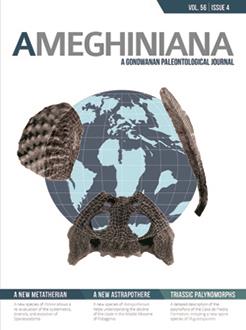Sparassodonts were the main mammalian predators during most of the Cenozoic in South America. The lower Eocene Itaboraí Basin/ Formation includes the second oldest fossil records of this group in South America: Patene Simpson and cf. Nemolestes Ameghino. Patene is by far the most abundant sparassodont from this formation, with more than 30 specimens referable to a single taxon, Patene simpsoni Paula Couto. Some specimens recovered from the Quebrada de Los Colorados Formation (formerly Lumbrera Formation – middle Eocene) in Northwestern Argentina have been also referred to P. simpsoni. In order to test the affinities of Patene and the taxonomy of the Argentinean specimens, we performed a review of the genus. Specimens of Patene from Northwestern Argentina show significant differences from the specimen from Brazil, including: smaller size; a relatively larger paraconid; and smaller metaconid, entoconid and hypoconid. As a result, the specimens from the Quebrada de Los Colorados Formation are assigned to a new taxon, Patene coloradensis sp. nov. The results of our phylogenetic analysis recover Patene as a basal sparassodont and support previous hypotheses that exclude Patene from the “Hathliacynidae”. The results also supported the hypothesis that Allqokirus australis Marshall & Muizon and Mayulestes ferox Muizon from the Tiupampa Basin (Santa Lucía Formation, lower Paleocene – Tiupampan SALMA), Bolivia, are the oldest known representatives of the Sparassodonta. The results also supported the monophyly of the Pucadelphyda with the inclusion of the Jaskhadelphyidae and closely related taxa in this group in addition to the Pucadelphyidae and Sparassodonta. The late Cretaceous North American Varalphadon Johanson was not recovered as a representative of the Sparassodonta in our phylogenetic analysis. Based on our results and the current fossil record, the Sparassodonta should be considered an endemic South American lineage.
How to translate text using browser tools
7 June 2019
Diversity, Affinities and Adaptations of the Basal Sparassodont Patene (Mammalia, Metatheria)
Caio César Rangel,
Leonardo M. Carneiro,
Lílian Paglarelli Bergqvist,
Édison Vicente Oliveira,
Francisco Javier Goin,
María Judith Babot
ACCESS THE FULL ARTICLE

Ameghiniana
Vol. 56 • No. 4
July 2019
Vol. 56 • No. 4
July 2019
Eocene
Itaboraí basin
Metatheria




